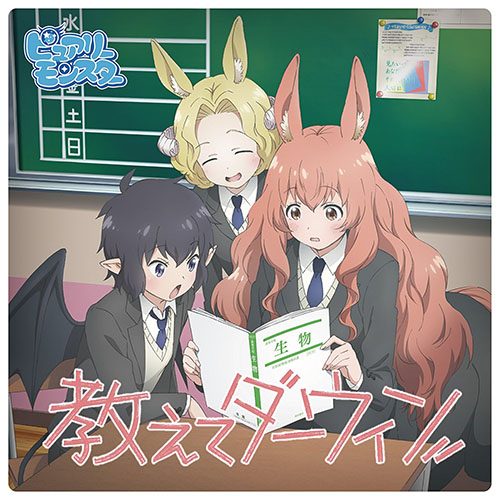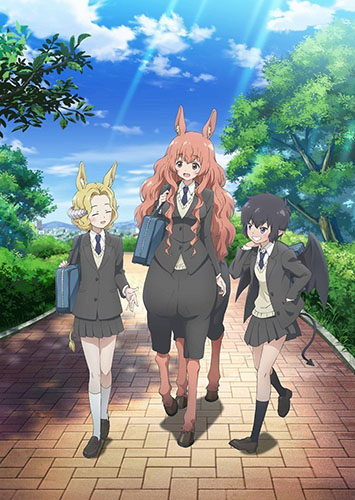
Should you hoof it to your TV?
- Episodes : 12
- Genre : Slice-of-Life, Comedy, Supernatural
- Airing Date : July 2017 – September 2017
- Studios : Haoliners Animation League
Contains Spoilers
Centaur’s Worries (Centaur no Nayami) Introduction and Story (Spoilers)
Himeno Kimihara (nicknamed “Hime”) is a just a normal centaur girl attending high school in Japan. She practices archery, hangs out with her best friends Nozomi (a demon girl) and Kyoko (a satyr girl), occasionally gets called in to model for a family friend’s magazine, and takes care of her young, fellow centaur cousin Shino. One day, Hime is informed that their class will soon have a foreign exchange student entering their school; a snake girl from Antarctica named Sassassul! Initially, Hime is frightened of Sassassul due to some trauma watching a horror movie about snake people, but the two quickly become friends and Sassassul joins her circle of close friends with Nozomi and Kyoko.
That’s about the most plot you’ll get from Centaur’s Worries. Effectively, each episode is split into two stories following the life of a different character. Most of the time we follow Hime, but we get stories following class president Mitama (an angel girl) as she looks after her four younger sisters while her father struggles to make it as a painter, Kyoko keeping her own father motivated as a writer, an entire subplot about the merpeople who live up in the mountains having their sacred ritual being interrupted by a false flag attack by the snake people, and even the story of a Japanese politician growing up in a concentration camp headed by centaurs.
As a result, Centaur’s Worries is a true slice-of-life story. There’s no greater goal; the first half of the first episode is about getting ready for the school play and adjusting the set to take into account for Hime’s extra weight due to her horse body, and the last half of the last episode is about the girls holding an impromptu arm wrestling competition because, why not? The story is more about how each vignette builds its world and how this alternate world of monsters functions; or rather, how it’s really no different from our world.
What We Liked about Centaur’s Worries
Ignore the surface level interpretation of Centaur’s Worries; it’s “cute monster girls living life” is really just a cover for more in-depth commentary on the current state of Japanese politics. You hear characters mention in passing how they can’t ride on Hime’s back or else they’ll be sent to a tolerance camp, notice in the background how certain areas of town have armed soldiers guarding their entrances, hear on the news about how the government providing assistance to the merpeople with devices that would allow them to walk around on land is reverse racism, and what not. What’s important about this is that never once does the series ever draw any attention to the politics of the world. So often fascism in media is hyper-stylized, with military that openly roams the streets and characters living in abject squalor. However, Centaur’s Worries depicts the true horror of fascism that’s overlooked; it arises because it becomes normalized in everyday life.
We see this normalization made evident in contrasting Hime’s life with her classmates. The fact of the matter is that Hime actually lives a pretty charmed life; her father has a decent job that allows her to live a fairly comfy life, she has a supportive circle of friends that would go so far as to help her through her latent racism towards snake people to keep her from getting sent to a camp, and most of her problems come from normal school issues dealing with a boy who has a crush on her or a rival on her archery team who’s unusually hostile towards her. Why would Hime care that the world is fascist? So long as she follows the rules, she’ll be fine. Meanwhile, Mitama is forced into playing parent to her rambunctious triplet sisters and her even younger, sickly sister because their father refuses to find a direction in his life, Sassassul is secretly tailed by a government agency that unfairly suspects her to be a terrorist due to an attack, and so forth. Societal issues are normal because, outside of Sassassul, their problems are internalized as their own issues rather than an issue with society itself.
Discussion Time
Centaur’s Worries is a fascinating series… to discuss. If you’re the type of viewer who loves to deep dive into analysis, then Centaur’s Life has a lot to offer despite it seemingly being just another monster fanservice show. But actually watching the show is another matter. Centaur’s Worries is effectively an “Iyashikei” (or healing) show, where the target audience consists largely of stressed out or depressed individuals who want to watch something relaxing and kind to make them feel good about themselves. These shows are by nature written to be gentle and non-confrontational. So the nature of its genre and its delivery creates an issue for both fans of Iyashikei and people wanting to take a more academic approach to the show; Iyashikei fans might find the subject matter too upsetting (particularly with episode 9 showcasing some incredibly grim imagery), while people who want to analyze the meat of the show might find it too slow-paced and directionless to really sink their teeth into.

1. In-Depth Character Building
One of the reasons why the overall message of Centaur’s Worries works is because of how much effort the series puts into making its characters relatable. Most other shows would denigrate Hime into a walking punchline or make her cluelessness about the world into a running gag while also claiming she has some deeper wisdom about how to live life. But Centaur’s Worries never addresses her issues in such a way. Instead, you empathize with Hime because her waifish, girly nature plays right into desire to protect, despite the fact that she’s got a literal horse body.
Meanwhile, Mitama is frequently depicted as being a bit of a killjoy and a stick in the mud. She’s not really a villain, per se, but there are moments that make you question what her problem is. She tells Mitsuyo and Inukai, her class’ lesbian couple, to not kiss in front of her little sisters because she thinks it’s perverted. You end up getting frustrated with Mitama, especially when you realize that she might be in the closet herself when caught out on a date at an art museum with another girl in their class. The series does what it can to turn you against the characters who actually are struggling in life, while making you root for the characters who don’t even need the help.
2. Reflection of Modern Society
As we’ve mentioned before, Centaur’s Worries is a reflection of modern day Japanese politics. It’s something that happens in the background of society that most people don’t even want to address. And Centaur’s Worries replicates that feeling in order to point out how strange it is that these serious issues are just ignored.
A great example of this is in episode 3, where Mitama’s little sisters are playing around and generally causing havoc. However, this scene is introduced to us by putting us in the middle of a magical girl anime that’s playing in the background, showcasing a dastardly demon who wants to change society into a world where only the majority opinion matters and our hero proclaims that democracy can only work by considering the minority as well. While the propaganda message is a bit on the nose, what’s important about the scene is the framing; the girls are hardly even paying attention to it while it plays as background noise. It shows how propaganda isn’t simply direct messages to people, but controlled information that subtly ingrains itself into your mindset from a young age.
3. Subverts itself in addition to the genre
It would have been extremely easy for the series to simply depict the fascist society in the background as being generally incompetent in order to spell out to the viewer why it’s bad. However, Centaur’s Worries actually has the mindset to understand there are still competent people at work within a fascist government. When Sassassul is being monitored in episode 10, one of the agents remarks to their boss that there are other girls who are following Sassassul and they might be a concern. The agent’s boss, however, immediately understands that they’re just some of Sassassul’s classmates who are following her because they believe she’s on a date and aren’t a concern. This highlights precisely why living in a fascist state is horrifying by emphasizing the organization’s competence; the agents correctly assume the best about Hime, Kyoko, and Nozomi, but needlessly stalk an innocent girl who’s just trying to understand more about an unfamiliar culture.
1. Extremely Dry at Times
Unfortunately, Centaur’s Worries is the type of show you have to consider as a whole and how all of its details serve to build up its central message. Honestly, while it works as great political commentary, it doesn’t work well if what you want is a simple, fun fanservice slice-of-life series. These sorts of shows generally work by falling on fun observational comedy about day to day life in Japan, or wacky situations the characters find themselves in.
Centaur’s Worries on the other hand at feels like watching a textbook description of another world play out. That’s not to say it can’t be interesting at times, but so much of the series is description on how certain, minute aspects of the world of the series works, like how when angels get a haircut and their hair halo gets cut off on accident, they can sign a form with their hairdresser or barber that states that the affected party realizes that it was not done maliciously. It maybe a bit interesting to understand how that might work in such a world, but it’s just told in dry, expositional language without a whole lot else to the scene. This makes watching it feel more like reading reference material rather than really engaging in an anime.
Final Thoughts
Centaur’s Worries is really a type of series that works better as a discussion piece rather than to watch. That’s not to say it’s not worth watching; if you’re interested in what we’ve stated, then you absolutely should go check it out. Just keep in mind it’s a slow burn, with maybe one or two sequences in an episode that completely change your interpretation of what you just saw. Because of that slow burn, though, sometimes Centaur’s Worries can be difficult to invest yourself in. That’s why it works best to watch it an episode at a time rather than as a full story. If you haven’t watched it yet, try and replicate the feeling of the broadcast airing and just watch an episode week to week.
Recommended Post
Centaur no Nayami - Summer 2017 Anime
Recommended Post

